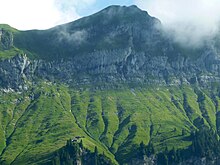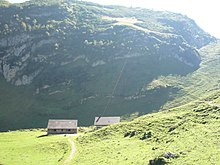Wild hay

Wild hay is a form common throughout the Alps to obtain hay on high, steep meadows that are difficult or impossible to reach with animals, right up to the alpine pastures ( alpine mowing , alpine hay ). In some regions, the meadows are also referred to as mountain meadows . This form of haymaking is dangerous; fatal accidents occur again and again.
Regional working methods for wild / alpine hay



The wild hay meadows are mostly communal in Switzerland and the relevant rules are set by the cooperative . For example, wild haying is only permitted from a certain point in time, and each family was only allowed to have two family members hay so that the yield was distributed fairly. From a purely agricultural point of view, the yield on the steepest slopes and with pure manual labor is so low that the work has no longer been worthwhile since the 1970s. Thanks to the support of voluntary helpers, larger meadows can be preserved. B. the Canton of Uri such programs. After mowing , the grass is laid out to dry and finally the hay bales are bundled with a transport network. These bundles are also known as "Burdi". A hay rope , a temporary cable car on which a 50 to 60 kilogram bundle of hay slides down into the valley, is often used for removal .
Wild haying is an important contribution to avalanche protection . On unmowed slopes, the blades of grass are pushed to the ground in the autumn by rain and the first snow in the falling direction and thus define a sliding plane similar to a thatched roof . Furthermore, the biodiversity on mown areas is higher and the ingredients of the hay differ from the more easily available grass in the flatlands and produce a different milk .
In Triesen ( Liechtenstein ) one speaks of hay in the hay mountains . The Bergheuen on Tuass , Hintertuass , Platta , Mascheren etc. was thanks to the lean meadow law reactivated. The purpose is on the one hand to preserve the cultural heritage and on the other hand to preserve the diversity of species. The old Triesner cultural landscape on the Heuberge, around 1400 m above sea level. M. , is mowed more often again today, but largely with motor mowers , which are suitable for mowing steep, rough meadows .
Media and documentation
On the Alp Odro above Vogorno in the Verzasca valley there is a museum about wild hay and at Rophaien in the canton of Uri an educational trail and wild hay courses. In 2016, the Swiss Landscape Protection Foundation named Uri's Isenthal with its wild hay fields the Swiss Landscape of the Year.
In 2006, the Swiss filmmaker Erich Langjahr dedicated the film The Heritage of the Mountains to the wild haymakers in the Muotatal .
Aviation obstruction
Temporarily tensioned hay ropes are not shown on aeronautical maps and are difficult to see without marking. They represent a high risk for low-flying helicopters. In 1992 a rescue helicopter in Tannheim (Tyrol) got caught in a hay rope and crashed. The emergency doctor hanging on the approx. 10 meter long mountain rope was killed.
literature
- Gustav Rischard, Emil Schmocker: The wild hay in Ringgenberg . Foreword by Arnold Niederer . Self-published by G. Ritschard, 1980.
- Hans Frommelt: The Heuberge received as Heuberge . In: Bergheimat . Season font Liecht. Alpine Club. 2000.
- Heinrich Hoch: 200 years Triesner Heuberge in private ownership (1808–2009) . 2009.
- Michael Dipner: Wildheuen: Alpine tradition before the comeback . (PDF) In: The Alps , 10/2006 (alpen.sac-cas.ch).
- ND: The wild haymaker . In: The Gazebo . Issue 16, 1866, pp. 251-253 ( full text [ Wikisource ]).
Web links
- Valle Vercasca - Ethnographic Tour (PDF; 973 kB) odro.ch
- Mythical world of Uri. ( Memento from July 27, 2010 in the Internet Archive ) (contains a legend "Wildheuer")
Individual evidence
- ↑ a b Wild hay for flatlands ; NZZ , August 10, 2013; detailed text and 12-minute film documentation
- ↑ Big award for Urner Wildheuer. SRF August 13, 2016
